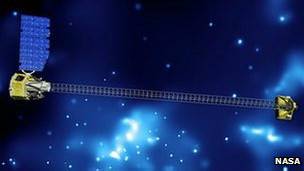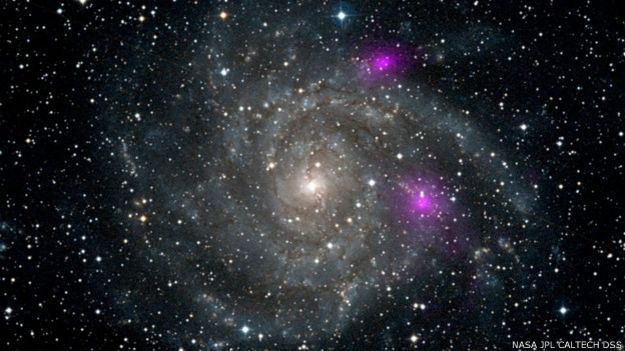Hola amigos: A VUELO DE UN QUINDE EL BLOG., la Agencia de Noticias BBC Mundo Noticias, nos alcanza la información sobre la captación de fotografías a El Sol, por la NASA por su Telescopio NASA's Nuclear Spectroscopic Telescope Array (NuSTAR), mostrándonos la cara nunca antes vista.
Para nuestro amigos de habla inglesa, les adjuntamos la información completa de NASA en la parte final.

Un telescopio de rayos X que fue diseñado para estudiar galaxias y agujeros negros ahora está centrando su atención en el Sol, mostrando una cara impresionante nunca antes vista de nuestra estrella.
El Telescopio Espectroscópico Nuclear Conjunto de la NASA (Nustar por sus siglas en inglés), fue lanzado y colocado en órbita en 2012. Ve al universo en rayos X a muy alta energía.
Nustar, que está trabajando más allá de sus dos años de misión originales, ha medido cuán rápido rotan los agujeros negros.
Las nuevas imágenes del Sol ahora demuestran que puede recopilar nueva información sobre la estrella.
Visión única
Debido a su alta sensibilidad, Nustar podría resolver algunos complicados rompecabezas, como por ejemplo, si existen las "nanollamaradas".
Estas supuestas versiones pequeñas de las gigantes llamaradas del Sol, podrían ayudar a explicar por qué su atmósfera exterior es mucho más calurosa que la superficial, una pregunta que tiene décadas sin ser respondida.
La primera vez que los físicos pensaron en usar a Nustar para estudiar al Sol fue cuando ya estaba en construcción.
"Al principio pensé que la idea era una locura", indicó la investigadora principal de la misión, la profesora Fiona Harrison, del Instituto de Tecnología de California.
"¿Para qué usarlo para ver nuestro propio patio trasero si se trata del telescopio más sensitivo de rayos X jamás construido, diseñado para mirar el universo profundo?".
Sin embargo, Harrison fue convencida por el profesor David Smith, un físico solar de la Universidad de California en Santa Cruz.

"Nustar nos dará una visión única del Sol, desde la atmósfera más profunda hasta la más alta", indica el profesor Smith.
Esto es posible debido a que los rayos X de alta energía de Nustar "ven" que nuestro sol no brilla tanto como en otras longitudes de onda. Ese brillo podría dañar los detectores de otros telescopios como el Observatorio Chandra de Rayos X de la NASA.
Además de observar al Sol, el equipo de Nustar también utilizará la extensión de la misión hasta 2016 para continuar estudiando objetos más lejanos como agujeros negros y restos de supernovas.

Sun Sizzles in High-Energy X-Rays
X-rays stream off the sun in this image showing
observations from by NASA's Nuclear Spectroscopic Telescope Array, or NuSTAR,
overlaid on a picture taken by NASA's Solar Dynamics Observatory (SDO).
Image Credit:
NASA/JPL-Caltech/GSFC
Feature Link:
For the first time, a mission designed to set its eyes on black holes and
other objects far from our solar system has turned its gaze back closer to home,
capturing images of our sun. NASA's Nuclear Spectroscopic Telescope Array, or
NuSTAR, has taken its first picture of the sun, producing the most sensitive
solar portrait ever taken in high-energy X-rays.
The image is available at:
"NuSTAR will give us a unique look at the sun, from the deepest to the
highest parts of its atmosphere," said David Smith, a solar physicist and member
of the NuSTAR team at University of California, Santa Cruz.
Solar scientists first thought of using NuSTAR to study the sun about seven
years ago, after the space telescope's design and construction was already
underway (the telescope launched into space in 2012). Smith had contacted the
principal investigator, Fiona Harrison of the California Institute of Technology
in Pasadena, who mulled it over and became excited by the idea.
"At first I thought the whole idea was crazy," says Harrison. "Why would we
have the most sensitive high energy X-ray telescope ever built, designed to peer
deep into the universe, look at something in our own back yard?" Smith
eventually convinced Harrison, explaining that faint X-ray flashes predicted by
theorists could only be seen by NuSTAR.
While the sun is too bright for other telescopes such as NASA's Chandra X-ray
Observatory, NuSTAR can safely look at it without the risk of damaging its
detectors. The sun is not as bright in the higher-energy X-rays detected by
NuSTAR, a factor that depends on the temperature of the sun's atmosphere.
This first solar image from NuSTAR demonstrates that the telescope can in
fact gather data about sun. And it gives insight into questions about the
remarkably high temperatures that are found above sunspots -- cool, dark patches
on the sun. Future images will provide even better data as the sun winds down in
its solar cycle.
"We will come into our own when the sun gets quiet," said Smith, explaining
that the sun's activity will dwindle over the next few years.
With NuSTAR's high-energy views, it has the potential to capture hypothesized
nanoflares -- smaller versions of the sun's giant flares that erupt with charged
particles and high-energy radiation. Nanoflares, should they exist, may explain
why the sun's outer atmosphere, called the corona, is sizzling hot, a mystery
called the "coronal heating problem." The corona is, on average, 1.8 million
degrees Fahrenheit (1 million degrees Celsius), while the surface of the sun is
relatively cooler at 10,800 Fahrenheit (6,000 degrees Celsius). It is like a
flame coming out of an ice cube. Nanoflares, in combination with flares, may be
sources of the intense heat.
If NuSTAR can catch nanoflares in action, it may help solve this decades-old
puzzle.
"NuSTAR will be exquisitely sensitive to the faintest X-ray activity
happening in the solar atmosphere, and that includes possible nanoflares," said
Smith.
What's more, the X-ray observatory can search for hypothesized dark matter
particles called axions. Dark matter is five times more abundant than regular
matter in the universe. Everyday matter familiar to us, for example in tables
and chairs, planets and stars, is only a sliver of what's out there. While dark
matter has been indirectly detected through its gravitational pull, its
composition remains unknown.
It's a long shot, say scientists, but NuSTAR may be able spot axions, one of
the leading candidates for dark matter, should they exist. The axions would
appear as a spot of X-rays in the center of the sun.
Meanwhile, as the sun awaits future NuSTAR observations, the telescope is
continuing with its galactic pursuits, probing black holes, supernova remnants
and other extreme objects beyond our solar system.
NuSTAR is a Small Explorer mission led by Caltech and managed by NASA's Jet
Propulsion Laboratory, also in Pasadena, for NASA's Science Mission Directorate
in Washington. The spacecraft was built by Orbital Sciences Corporation, Dulles,
Virginia. Its instrument was built by a consortium including Caltech; JPL; the
University of California, Berkeley; Columbia University, New York; NASA's
Goddard Space Flight Center, Greenbelt, Maryland; the Danish Technical
University in Denmark; Lawrence Livermore National Laboratory, Livermore,
California; ATK Aerospace Systems, Goleta, California; and with support from the
Italian Space Agency (ASI) Science Data Center.
NuSTAR's mission operations center is at UC Berkeley, with the ASI providing
its equatorial ground station located at Malindi, Kenya. The mission's outreach
program is based at Sonoma State University, Rohnert Park, California. NASA's
Explorer Program is managed by Goddard. JPL is managed by Caltech for NASA.
For more information, visit:
BBC y NASA
Guillermo Gonzalo Sánchez Achutegui
Inscríbete en el Foro del blog y participa : A Vuelo De Un Quinde - El Foro!


No hay comentarios:
Publicar un comentario